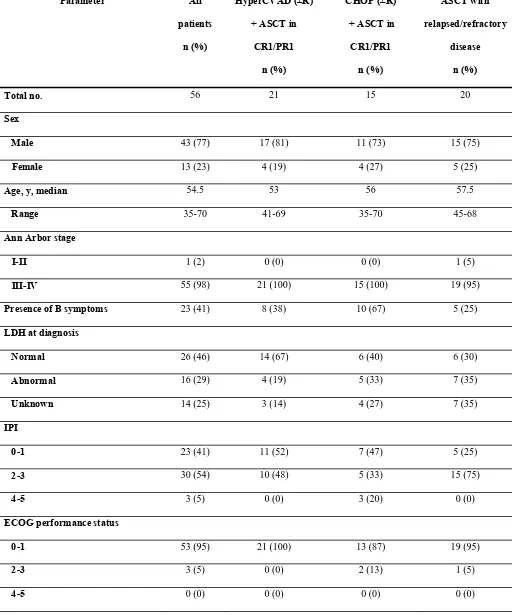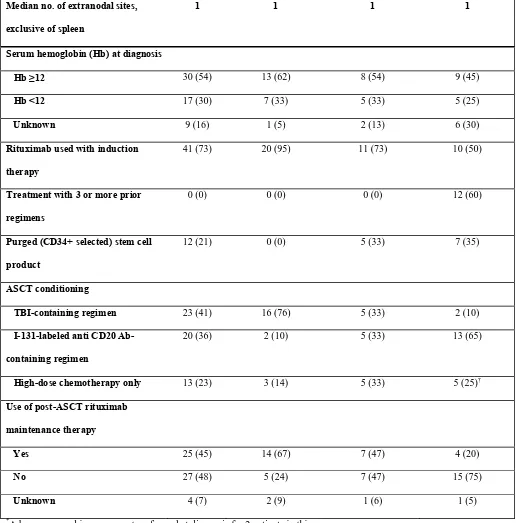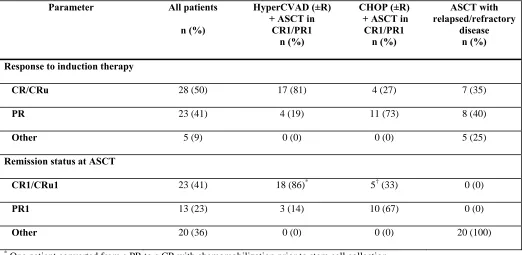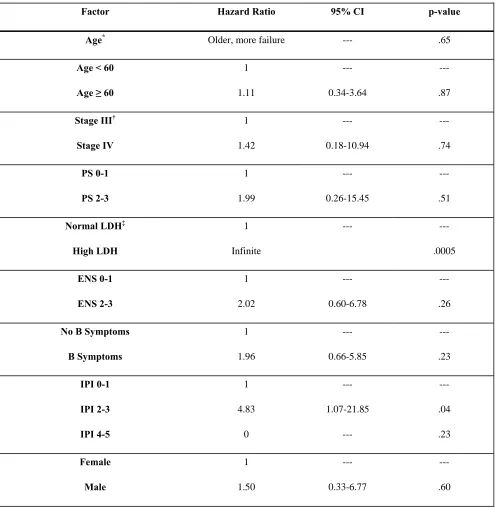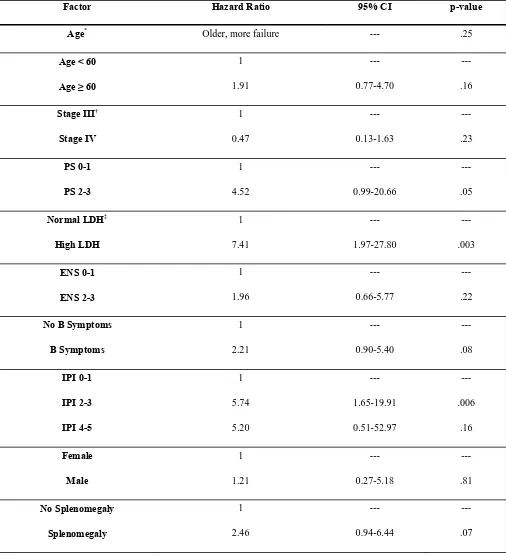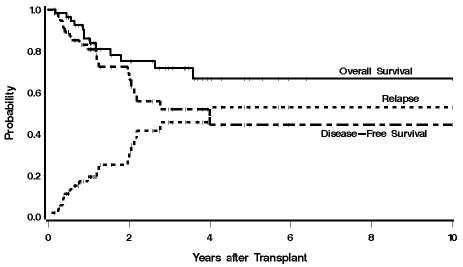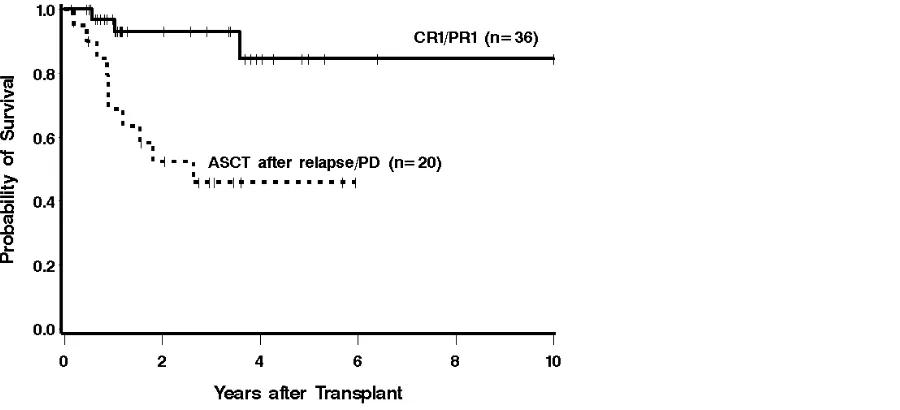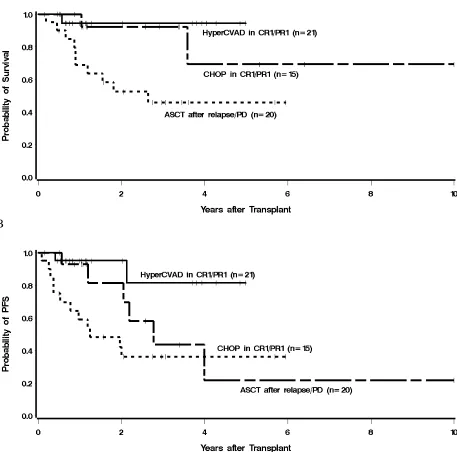Effect of Remission Status and Induction Chemotherapy Regimen on Outcome of Autologous Stem Cell Transplantation for Mantle Cell Lymphoma
Short Running Title: Remission Status and ASCT outcome in MCL
Brian G. Till, MD1,2 Theodore A. Gooley, PhD1,3 Nathan Crawford,1 Ajay K. Gopal, MD1,2 David G. Maloney, MD, PhD1,2 Stephen H. Petersdorf, MD1,2 John M. Pagel, MD, PhD1,2 Leona Holmberg, MD, PhD1,2 William Bensinger, MD1,2 Oliver W. Press, MD, PhD1,2
1
Clinical Research Division of the Fred Hutchinson Cancer Research Center, Seattle; 2
Department of Medicine, Division of Medical Oncology, University of Washington, Seattle; 3
Department of Biostatistics, University of Washington, Seattle
Corresponding author: Brian Till, MD, Fred Hutchinson Cancer Research Center, 1100 Fairview
Ave N., D3-190, Seattle, WA 98109-1024; e-mail: tillb@fhcrc.org, phone 206-667-7269, fax 206-667-1874
Keywords:
Mantle cell lymphoma
Autologous stem cell transplantation HyperCVAD
CHOP
Non-Hodgkin lymphoma
ABSTRACT
We analyzed the outcomes of autologous stem cell transplantation (ASCT) following high-dose
therapy with respect to remission status at the time of transplantation and induction regimen used
in 56 consecutive patients with mantle cell lymphoma (MCL). Twenty-one patients received
induction chemotherapy with HyperCVAD with or without rituximab (±R) followed by ASCT in
first complete or partial remission (CR1/PR1), 15 received CHOP (±R) followed by ASCT in
CR1/PR1, and 20 received ASCT following disease progression. Estimates of overall and
progression-free survival (PFS) at three years among patients transplanted in CR1/PR1 were
93% and 63% compared with 46% and 36% for patients transplanted with relapsed/refractory
disease, respectively. The hazard of mortality among patients transplanted with
relapsed/refractory disease was 6.09 times that of patients transplanted in CR1/PR1 (P=.006).
Patients in the CHOP (±R) group had a higher risk of failure for PFS compared to patients in the
HyperCVAD (±R) group, though the difference did not reach statistical significance (hazard
ratio 3.67,P=.11). These results suggest that ASCT in CR1/PR1 leads to improved survival
outcomes for patients with MCL compared to ASCT with relapsed/refractory disease, and a
HyperCVAD (±R) induction regimen may be associated with an improved PFS among patients
INTRODUCTION
Mantle cell lymphoma (MCL) has the worst prognosis of all non-Hodgkin lymphoma (NHL)
subtypes, with the possible exception of peripheral T cell lymphoma [1]. MCL is incurable with
conventional therapies, with a median overall survival (OS) of 3-4 years from diagnosis in most
series [1-3]. During the last 10 years, high-dose therapy followed by autologous stem cell
transplantation (ASCT) has become an increasingly common treatment for MCL. Initally, ASCT
was reserved as salvage therapy for relapsed or refractory disease, but outcomes were poor with
this strategy [4,5]. In these studies, less heavily pre-treated patients had a longer duration of
progression-free survival (PFS), suggesting that ASCT may lead to better outcomes if used
earlier in the course of therapy. Subsequent trials assessed ASCT in first complete (CR1) or
partial (PR1) remission, and although follow-up was generally short, compared to the earlier
trials the median OS improved to approximately 5-6 years [6-12], and some studies demonstrated
plateaus on the PFS curves, suggesting possible curability [8,9,13,14].
The first prospective evidence showing a benefit for ASCT in first remission compared with
conventional chemotherapy alone came from a trial by Dreyling et al. [15] They reported that
patients randomized to induction therapy with a CHOP-like regimen followed by ASCT in
CR1/PR1 had an improved median PFS (39 mo. vs. 17 mo., P = .01) compared with patients
who received chemotherapy followed by interferon maintenance.
Anthracycline-containing induction regimens appear to lead to the best response rates and
longest response durations for MCL [16-21], with the most commonly employed regimens being
alternating with cycles of high-dose methotrexate and cytarabine) with or without rituximab
(±R), or CHOP (cyclophosphamide, doxorubicin, vincristine, and prednisone) (±R) [20,21]. No
randomized trials have compared these regimens, but limited retrospective data suggest that
HyperCVAD may be superior to a CHOP-like regimen before ASCT [22,23]. We reviewed
outcomes after ASCT at our institution with respect to remission status at the time of ASCT, as
well as induction regimen, with particular attention to HyperCVAD (±R) vs. CHOP (±R), to
assess differences in PFS and OS and to examine prognostic factors.
PATIENTS, MATERIALS, AND METHODS
Selection of Patients
Consecutive patients with a confirmed diagnosis of MCL treated with ASCT between August
1996 and July 2006 were included. Forty-eight of 56patients had evidence of the (11;14)
translocation either by polymerase chain reaction (PCR), fluorescence in situ hybridization
(FISH), or cyclin D1 overexpression by immunohistochemistry, whereas 8 patients were
diagnosed strictly based on histological appearance and immunophenotypic profile (CD5+,
CD20+, CD23-) as outlined by the World Health Organization [24]. Patients were required to
have acceptable organ function, performance status, and otherwise be deemed transplantation
candidates by their primary oncologist. ASCT was performed at the Fred Hutchinson Cancer
Research Center, the University of Washington Medical Center, or the Puget Sound Veterans
Affairs Medical Center. Patients who received tandem ASCT followed by allogeneic stem cell
transplantation were excluded from this analysis.
Newly diagnosed patients were treated with induction chemotherapy with a variety of regimens,
according to the preference of their primary oncologist. Most patients received either CHOP
(±R) or HyperCVAD (±R) alternating with high-dose methotrexate (MTX) and cytarabine
(Ara-C). The induction regimens used in the group of patients who subsequently underwent ASCT
with relapsed or refractory disease (Group 3 under the Statistical Analysis section) were: CHOP
(±R) (11 patients), CVP (±R) (3 patients), fludarabine (±R) (2 patients), R-HyperCVAD (1
patient), R-EPOCH (1 patient), antisense Bcl-2 inhibitor (1 patient), and local neck radiotherapy
(1 patient). Some patients were referred to the transplant service for ASCT in CR1 or PR1, while
others were referred after salvage therapy for relapsed/refractory disease. All patients underwent
stem cell collection by apheresis after mobilization with filgrastim with or without
chemotherapy. Patients were then treated with high-dose therapy followed by infusion of
cryopreserved autologous peripheral blood stem cells. The conditioning regimens used were total
body irradiation (TBI) with cyclophosphamide and etoposide (23 patients); iodine-131-labelled
tositumomab alone (7 patients), or in combination with cyclophosphamide and etoposide (12
patients) or fludarabine (1 patient); and BEAM (BCNU, etoposide, cytarabine, and melphalan) or
bulsulfan, thiotepa, and melphalan (13 patients). Stem cell products of selected patients with
evidence of peripheral blood involvement by MCL prior to stem cell collection underwent ex
vivo purging by immunoaffinity selection of CD34+ cells. The stem cell product of 1 patient
underwent B-cell depletion in addition to ex vivo purging. Patients were observed for
transplant-related toxicities in the immediate post-transplant period and then referred back to their primary
oncologists for monitoring. Twenty-five patients were treated with post-ASCT rituximab
maintenance therapy of varying schedules.
Estimates of OS and PFS were obtained with the method of Kaplan and Meier and calculated
from the time of transplant. The probability of relapse was summarized using cumulative
incidence estimates, where death without relapse was regarded as a competing risk.
Comparisons of the hazard of failure for OS and PFS were made using Cox regression.
Comparisons of primary interest involved remission status at time of ASCT, where patients were
categorized as being transplanted either in CR1/PR1 or with relapsed or refractory disease, and
induction regimen, where patients received either HyperCVAD (±R), CHOP (±R). Because only
one patient of 21 who received HyperCVAD was transplanted after relapse or progression
compared to 11 of 26 patients who received CHOP for induction, a comparison of CHOP and
HyperCVAD was restricted to patients transplanted in first remission. Patients were categorized
based on remission status and induction regimen as follows: Group 1: HyperCVAD (±R)
followed by ASCT in CR1/PR1; Group 2: CHOP (±R) followed by ASCT in CR1/PR1; and
Group 3: ASCT with relapsed or refractory disease. Three patients in the CHOP group received
an additional chemotherapy regimen in PR1 in an unsuccessful attempt to achieve a CR and were
considered to be in PR1 at ASCT. A fourth patient in the CHOP group achieved a CR after 2
additional cycles of chemotherapy (R-HyperCVAD) in PR1 and was considered to be a CHOP
patient in CR1 at ASCT. Groups 1 and 2 were then combined to analyze the differences between
patients who underwent ASCT in CR1/PR1 and patients who underwent ASCT with relapsed or
refractory disease (Group 3), and the impact of CHOP vs. HyperCVAD among patients
transplanted in CR1/PR1 was assessed by comparing Groups 1 and 2.
Responses were determined according to the International Working Group criteria [25]. The
pre-treatment serum lactate dehydrogenase (LDH) values of several patients who underwent
Prognostic Index (IPI) scores were calculated assuming a normal LDH value; thus, the IPI scores
may be underestimated for those patients.
Factors other than remission status at ASCT and induction regimen were assessed for their
association with outcome. These factors included age at diagnosis, sex, stage at diagnosis, serum
LDH at diagnosis, performance status at diagnosis, IPI score, presence of bone marrow or
gastrointestinal tract involvement, presence of splenomegaly, number of extranodal sites of
disease, presence of B symptoms, serum hemoglobin (Hb) at diagnosis, number of cycles of
induction chemotherapy, use of rituximab with induction, number of pre-ASCT chemotherapy
regimens (not counting mobilization), response to induction therapy, preparatory regimen for
ASCT, and post-ASCT rituximab therapy. The impact of using rituximab after ASCT was
assessed by considering rituximab use as a time-dependent covariate, with the covariate
assuming a value of 0 until the time of first administration of rituximab following ASCT, at
which time the covariate assumes the value 1. The relatively small number of events limited the
number of factors that could be included in a multivariate model to two. All two-sided p-values
from regression models were calculated using the Wald test.
Institutional Approval
Institutional approval from the Fred Hutchinson Cancer Research Center was obtained to
evaluate patients’ medical records retrospectively. Patients were either enrolled into
institutionally approved studies or treated with standard transplantation protocols.
Patients
Fifty-six consecutive patients (median age at diagnosis 54.5, range 35-70) were treated with
high-dose therapy followed by ASCT at our center between August 1996 and July 2006, with a
median follow-up time among survivors of 24.6 months and maximum follow-up time of 10.1
years. Patient characteristics are listed in Table I. All patients had pathologically confirmed
MCL, with 48 of 56 patients having either positive cyclin D1 by immunohistochemistry or
evidence of t(11;14) by FISH or PCR. All patients but 1 (98%) had stage III-IV disease, and 77%
of patients were male.
Baseline characteristics were similar among the primary comparison groups, with a few
exceptions. A higher percentage of patients treated with CHOP (±R) followed by ASCT in
CR1/PR1 had B symptoms (67%) than patients treated with HyperCVAD (±R) followed by
ASCT in CR1/PR1 (38%) or patients with relapsed/refractory disease at the time of ASCT
(25%). A slightly higher percentage of patients in the CHOP group had a performance status of 2
or greater compared with patients in the HyperCVAD group (13% and 0%, respectively). More
patients with relapsed/refractory disease at ASCT had an IPI score at diagnosis of 2 or greater
than patients transplanted in first remission (75% and 50%, respectively).
Response to Induction
With respect to the 3 comparison groups, 21 patients were treated with a HyperCVAD (±R)
regimen followed by ASCT in CR1/PR1, 15 patients were treated with CHOP (±R) followed by
ASCT in CR1/PR1, and 20 patients underwent ASCT with relapsed/refractory disease (Table I).
complete response unconfirmed (CR/CRu) to induction, compared with only 4 of 15 patients
(27%) in the CHOP group (P = .002). Among patients who underwent ASCT after relapse, 15
(75%) had a response to initial induction therapy (7 CR/CRu, 8 PR), 3 patients had stable
disease, and 2 had progressive disease (Table II). Fifteen of the 20 patients had chemosensitive
disease at ASCT, as defined by cumulative response (CR or PR) since the time of last
relapse/progression. All 5 of the primary refractory patients subsequently responded to salvage
chemotherapy regimens. Patients were more likely to receive a CHOP (±R) regimen in the early
years of the study and more likely to receive HyperCVAD (±R) in more recent years. The
median follow-up of survivors in the CHOP group was 31 months, and the median follow-up for
survivors in the HyperCVAD group was 14 months. This difference was due primarily to the
three long-term survivors in the CHOP group; the number of patients with follow-up less than 3
years was more similar between the two groups: 13/20 (65%) of the HyperCVAD patients and
7/13 (54%) of the CHOP patients. There is only one death beyond 3 years (at 3.6 years in CHOP
group).
Outcomes After Stem Cell Transplantation
At most recent follow-up, 13 patients had died, 12 of progressive disease, and 1 patient, in the
relapsed/refractory group, from refractory cytopenias leading to a fatal infection (1.8%
transplant-related mortality). There were 19 relapses, 12 of which led to death. The median OS
of the entire group was not yet reached, and the median PFS was 4.0 years, with estimated 3-year
OS and PFS of 72% and 52%, respectively (Figure 1).
Patients who underwent ASCT in CR1/PR1 had an estimated 3-year OS of 93% compared to
years was estimated to be 63% and 35%, respectively, in these 2 groups of patients. Risk of
mortality and risk of PFS failure were increased among patients undergoing ASCT with
relapsed/refractory disease compared to patients transplanted in CR1/PR1 (HR 6.09 [95% CI
1.66-22.30], P = .006, and HR 3.15 [1.28-7.71], P = .01, respectively).
Given the low number of deaths among patients transplanted in CR1/PR1 (2 in the CHOP group
and 1 in the HyperCVAD group), a statistical comparison of mortality between these 2 induction
regimens is not meaningful. Among patients treated with HyperCVAD (±R) followed by ASCT
in first remission, the median OS and PFS have not been reached. Among patients treated with
CHOP (±R) followed by ASCT in CR1/PR1, the median OS was not yet reached, and the median
PFS was 33.2 months. The estimated 3-year PFS was 81% for patients in the HyperCVAD group
and 44% for patients in the CHOP group (Figure 3). The hazard of failure for PFS among CHOP
(±R) patients transplanted in CR1/PR1 was 3.67 (95% CI 0.77-18.24) times that of patients in the
HyperCVAD group, but this difference did not reach statistical significance (P = .11).
One patient in the relapsed/refractory group developed a melanoma 5 years after ASCT.
Excluding non-melanoma skin malignancies, no other secondary malignancies were reported
among the study patients after ASCT.
Prognostic Factors Other than Induction Regimen and Remission Status at Transplant
A number of factors other than induction regimen and remission status at transplant were
examined for their association with overall mortality and failure for PFS (Table III). Because of
the limited number of events (13 deaths, 20 deaths or relapses), the number of factors that could
elevated LDH was associated with an increased risk of death (44%, compared to 0%, P = .0002).
Patients with an IPI of 0-1 were less likely to die compared to patients with higher IPI scores
(9% of patients with IPI of 0-1, compared to 33% with higher IPI, HR 0.23 [0.05-1.03], P = .05),
and patients whose induction regimen contained rituximab were also less likely to die compared
to those whose regimen did not contain rituximab (15% compared to 47%, HR 0.33 [0.11-1.00],
P = .05). Similarly, patients who received rituximab after transplantation had a reduced hazard
ratio for mortality (0.13 [0.02-1.03], P = .05). No other factors were statistically significantly
associated with mortality. After adjusting for IPI score (0-1 vs. 2-5), the hazard of mortality
among patients transplanted with relapsed/refractory disease remained statistically significantly
higher than among patients transplanted in first remission, although the magnitude of the
difference was reduced (HR 5.12, P = .02). A similar finding held after adjusting for use of
rituximab in the induction regimen (HR 5.13, P = .02). Adjusting for conditioning regimen
(modeled as TBI-containing vs. I-131-containing vs. high-dose chemotherapy only) likewise did
not reduce the association of ASCT in first remission with improved survival (HR 13.37, P =
.005), and adjusting for the use of rituximab following ASCT led to the same qualitative
conclusion with respect to ASCT in first remission (HR 4.62, P = .03).
The same factors listed above associated with mortality were associated with PFS (Table IV).
Additionally, a better response to induction was associated with improved PFS; patients
achieving a PR as opposed to a CR had a hazard ratio (HR) of 5.88 for relapse or mortality
(1.67-20.67, P = .006), and patients that did not achieve either a CR or PR had a HR of 16.43
(3.51-76.84, P = .0004). Adjusting for IPI or use of rituximab during induction did not change the
conclusion with respect to the association seen between remission status at ASCT and PFS,
HR 2.62, P = .04 after adjusting for rituximab). The association fell below the level of statistical
significance after adjusting for conditioning regimen (HR 2.46, P = .08), as it did after separately
adjusting for rituximab use following ASCT (HR 2.30, P = .10). No other factors examined were
statistically significantly associated with the risk of relapse/mortality.
DISCUSSION
Historically, the use of ASCT in patients with MCL began as a salvage therapy for relapsed or
refractory disease, although it later became clear that survival results were poor with this
approach [4,5,26]. Several studies subsequently emerged suggesting improved clinical outcomes
for patients transplanted in first remission compared with historical controls or patients receiving
delayed transplants [8,27-29]. This evidence was supported by a prospective trial showing
improved PFS for patients randomized to ASCT rather than interferon maintenance following
induction chemotherapy [15]. Based on these data, and encouraged by technical advances in the
management of complications related to stem cell transplantation, ASCT as consolidation
therapy in first remission has become the preferred treatment for MCL for many oncologists and
hematologists, although this practice remains controversial.
In this study we evaluated outcomes of patients with MCL after ASCT with respect to their
remission status at the time of transplant and the induction regimen they received. We found that
patients who underwent ASCT in first remission had significantly better OS and PFS after ASCT
relapsed/refractory disease had an IPI score greater than 2 compared with patients in CR1/PR1 at
ASCT, this did not appear to account for the observed difference between the groups, as a
multivariable analysis adjusting for IPI continued to show an OS and PFS benefit for the patients
transplanted in first remission.The OS benefit also remained significant after adjusting for
conditioning regimen, although the PFS benefit was reduced. We also found that patients
achieving less than a CR with induction therapy had a significantly higher risk of mortality
compared with patients who achieved a CR.
These results, along with studies demonstrating better outcomes among patients transplanted in
CR1 as opposed to PR1 [23,27], highlight the importance of optimizing the initial response to
chemotherapy and remission status at ASCT. It is important to emphasize that the current data do
not, and cannot, address the question of whether ASCT is preferred over not being transplanted,
as only patients who proceeded to ASCT are currently considered.
Recent years have seen a shift in the most commonly employed induction regimens for
previously untreated MCL as data on newer regimens have emerged. More intensive regimens
such as a HyperCVAD/MTX-Ara-C regimen, in combination with rituximab, are increasingly
being used in favor of older regimens such as R-CHOP and R-CVP, although the optimal
induction regimen has not yet been firmly established. One series by Conde et al. compared
post-ASCT outcomes of patients from an international database with respect to induction regimen,
and found a 4-year disease-free survival of 68% for patients treated with HyperCVAD compared
with 33% for patients treated with a CHOP-like regimen [22]. In a more recent abstract by Vose
et al. of 80 patients who underwent ASCT in CR1/PR1, patients who were treated with a
patients who were treated with a CHOP-like (±R) induction regimen [23]. Additionally, a subset
analysis of a study by Ganti et al. suggested that a HyperCVAD (±R) induction regimen was
associated with fewer relapses [30].
In this study we compared the outcomes of patients treated with ASCT in CR1/PR1 after
receiving either a HyperCVAD/MTX-Ara-C (±R) or CHOP (±R) induction regimen. A statistical
comparison of these 2 groups with respect to OS is difficult, since there were only 3 deaths
among patients transplanted in first remission (2 in the CHOP group and 1 in the HyperCVAD
group). With regard to PFS, however, there was a higher risk of failure among patients in the
CHOP (±R) group, primarily through a higher risk of relapse, compared to those treated with
HyperCVAD (±R). The difference did not reach statistical significance, but the power to detect
such a difference was limited by the small number of events. That the estimated 3-year OS and
PFS of patients in this group were very similar to those reported by Vose et al., however,
increases one’s confidence that this PFS trend reflects a true superiority of HyperCVAD (±R) in
MCL. Furthermore, there was a significantly better CR/CRu rate among patients in the
HyperCVAD group compared with those in the CHOP group (81% vs. 27%). As with any
retrospective study, however, there were limitations. For example, more patients in the CHOP
group had high-risk disease based on IPI score, and fewer patients received rituximab as part of
induction compared with patients in the HyperCVAD group, which may have contributed to their
lower CR rate with induction and PFS. We must also acknowledge that the median follow-up of
patients in the CHOP group is longer than patients in the HyperCVAD group, and that it is
possible that this difference might have influenced our findings. The above differences mainly
reflect changes in treatment preference over time; in the earlier years of the study, more patients
more recent years, patients were more frequently treated with a HyperCVAD induction regimen
that included rituximab.
Although HyperCVAD appears to be associated with higher toxicity than CHOP [16,20,21] and
requires hospitalization for infusion, it was not associated with a higher rate of mortality during
subsequent transplantation. Only one patient died without a preceding relapse (1.8% non-relapse
mortality). It should be noted, however, that patients who died during induction or were
otherwise not able to tolerate ASCT were not included in this study. The incidence of secondary
malignancies was 1 of 56 (1.8%), though a longer follow-up time will be needed to address this
concern adequately.
An unresolved question concerning MCL is whether ASCT is curative. Previous series present
conflicting results, with some studies showing apparent plateaus on PFS curves, whereas others
do not [6-11,13-15,28,31-33]. Nevertheless, it is clear that many patients achieve long-term
disease-free intervals following ASCT in first remission. One patient on this study remains in a
molecular CR more than 10 years after ASCT, and is likely cured. Further studies are needed to
identify pre-treatment characteristics predictive of long-term survival with induction plus ASCT
or intensive induction alone.
In conclusion, the results of this study suggest that treating MCL patients with ASCT in first
remission affords a survival benefit when compared to ASCT after relapse or progression. Our
data also show that among patients who are transplanted in CR1/PR1, those who receive
HyperCVAD (±R) followed by ASCT may have improved PFS compared to those treated with
associated with the HyperCVAD regimen, randomized trials to confirm these results are
warranted.
ACKNOWLEDGEMENTS
This research was supported by NIH Grant P01 CA44991 (O. Press), Lymphoma Research
Foundation Mantle Cell Lymphoma Research Initiative, K23CA85479 (A. Gopal), and gifts
from the Hext Family Foundation, the Edson Foundation, The Jose Carreras Foundation Against
Leukemia, David and Patricia Giuliani, Mary and Geary Britton-Simmonds, James and Sherry
REFERENCES
1. Armitage JO, Weisenburger DD. New approach to classifying non-Hodgkin's
lymphomas: clinical features of the major histologic subtypes. Non-Hodgkin's
Lymphoma Classification Project. J Clin Oncol 1998;16:2780-2795.
2. Bosch F, Lopez-Guillermo A, Campo E, Ribera JM, Conde E, Piris MA, et al. Mantle
cell lymphoma: presenting features, response to therapy, and prognostic factors. Cancer
1998;82:567-575.
3. Oinonen R, Franssila K, Teerenhovi L, Lappalainen K, Elonen E. Mantle cell lymphoma:
clinical features, treatment and prognosis of 94 patients. Eur J Cancer 1998;34:329-336.
4. Freedman AS, Neuberg D, Gribben JG, Mauch P, Soiffer RJ, Fisher DC, et al. High-dose
chemoradiotherapy and anti-B-cell monoclonal antibody-purged autologous bone marrow
transplantation in mantle-cell lymphoma: no evidence for long-term remission. J Clin
Oncol 1998;16:13-18.
5. Vose JM, Bierman PJ, Weisenburger DD, Lynch JC, Bociek Y, Chan WC, et al.
Autologous hematopoietic stem cell transplantation for mantle cell lymphoma. Biol
Blood Marrow Transplant 2000;6:640-645.
6. Khouri IF, Saliba RM, Okoroji GJ, Acholonu SA, Champlin RE. Long-term follow-up of
autologous stem cell transplantation in patients with diffuse mantle cell lymphoma in first
disease remission: the prognostic value of beta2-microglobulin and the tumor score.
Cancer 2003;98:2630-2635.
7. Lefrere F, Delmer A, Levy V, Delarue R, Varet B, Hermine O. Sequential chemotherapy
regimens followed by high-dose therapy with stem cell transplantation in mantle cell
8. Mangel J, Leitch HA, Connors JM, Buckstein R, Imrie K, Spaner D, et al. Intensive
chemotherapy and autologous stem-cell transplantation plus rituximab is superior to
conventional chemotherapy for newly diagnosed advanced stage mantle-cell lymphoma:
a matched pair analysis. Ann Oncol 2004;15:283-290.
9. Oinonen R, Jantunen E, Itala M, Lehtinen T, Kuittinen O, Franssila K, et al. Autologous
stem cell transplantation in patients with mantle cell lymphoma. Leuk Lymphoma
2002;43:1229-1237.
10. Ritchie DS, Seymour JF, Grigg AP, Roberts AW, Hoyt R, Thompson S, et al. The
hyper-CVAD-rituximab chemotherapy programme followed by high-dose busulfan, melphalan
and autologous stem cell transplantation produces excellent event-free survival in patients
with previously untreated mantle cell lymphoma. Ann Hematol 2007;86:101-105.
11. Vigouroux S, Gaillard F, Moreau P, Harousseau JL, Milpied N. High-dose therapy with
autologous stem cell transplantation in first response in mantle cell lymphoma.
Haematologica 2005;90:1580-1582.
12. Vandenberghe E, Ruiz de Elvira C, Loberiza FR, Conde E, Lopez-Guillermo A,
Gisselbrecht C, et al. Outcome of autologous transplantation for mantle cell lymphoma: a
study by the European Blood and Bone Marrow Transplant and Autologous Blood and
Marrow Transplant Registries. Br J Haematol 2003;120:793-800.
13. Haas R, Brittinger G, Meusers P, Murea S, Goldschmidt H, Wannenmacher M, Hunstein
W. Myeloablative therapy with blood stem cell transplantation is effective in mantle cell
lymphoma. Leukemia 1996;10:1975-1979.
14. de Guibert S, Jaccard A, Bernard M, Turlure P, Bordessoule D, Lamy T. Rituximab and
DHAP followed by intensive therapy with autologous stem-cell transplantation as
15. Dreyling M, Lenz G, Hoster E, Van Hoof A, Gisselbrecht C, Schmits R, et al. Early
consolidation by myeloablative radiochemotherapy followed by autologous stem cell
transplantation in first remission significantly prolongs progression-free survival in
mantle-cell lymphoma: results of a prospective randomized trial of the European MCL
Network. Blood 2005;105:2677-2684.
16. Lenz G, Dreyling M, Hoster E, Wormann B, Duhrsen U, Metzner B, et al.
Immunochemotherapy with rituximab and cyclophosphamide, doxorubicin, vincristine,
and prednisone significantly improves response and time to treatment failure, but not
long-term outcome in patients with previously untreated mantle cell lymphoma: results of
a prospective randomized trial of the German Low Grade Lymphoma Study Group
(GLSG). J Clin Oncol 2005;23:1984-1992.
17. Nickenig C, Dreyling M, Hoster E, Pfreundschuh M, Trumper L, Reiser M, et al.
Combined cyclophosphamide, vincristine, doxorubicin, and prednisone (CHOP)
improves response rates but not survival and has lower hematologic toxicity compared
with combined mitoxantrone, chlorambucil, and prednisone (MCP) in follicular and
mantle cell lymphomas: results of a prospective randomized trial of the German
Low-Grade Lymphoma Study Group. Cancer 2006;107:1014-1022.
18. Zucca E, Roggero E, Pinotti G, Pedrinis E, Cappella C, Venco A, Cavalli F. Patterns of
survival in mantle cell lymphoma. Ann Oncol 1995;6:257-262.
19. Zinzani PL, Magagnoli M, Moretti L, De Renzo A, Battista R, Zaccaria A, et al.
Randomized trial of fludarabine versus fludarabine and idarubicin as frontline treatment
20. Howard OM, Gribben JG, Neuberg DS, Grossbard M, Poor C, Janicek MJ, Shipp MA.
Rituximab and CHOP induction therapy for newly diagnosed mantle-cell lymphoma:
molecular complete responses are not predictive of progression-free survival. J Clin
Oncol 2002;20:1288-1294.
21. Romaguera JE, Fayad L, Rodriguez MA, Broglio KR, Hagemeister FB, Pro B, et al. High
rate of durable remissions after treatment of newly diagnosed aggressive mantle-cell
lymphoma with rituximab plus hyper-CVAD alternating with rituximab plus high-dose
methotrexate and cytarabine. J Clin Oncol 2005;23:7013-7023.
22. Conde E, Marco F, Caballero D, et al. Autologous stem cell transplantation (ASCT) for
mantle cell lymphoma (MCL) [abstract]. Blood 2002;100:2529a.
23. Vose J, Loberiza FR, Bierman PJ, Bociek G, Armitage JO. Mantle cell lymphoma
(MCL): Induction therapy with HyperCVAD/High dose methotrexate and cytarabine
(M-C) (+/- rituximab) improves results of autologous stem cell transplant in first remission. J
Clin Oncol 2006;24:7511a.
24. Jaffe ES, Harris NL, Stein H, Vardiman J, editors. World Health Organization
Classification of Tumours: Pathology and Genetics of Tumours of Haematopoietic and
Lymphoid Tissues. Lyon: IARC Press; 2001.
25. Cheson BD, Horning SJ, Coiffier B, Shipp MA, Fisher RI, Connors JM, et al. Report of
an international workshop to standardize response criteria for non-Hodgkin's lymphomas.
NCI Sponsored International Working Group. J Clin Oncol 1999;17:2454-2460.
26. Ketterer N, Salles G, Espinouse D, Dumontet C, Neidhardt-Berard EM, Moullet I, et al.
Intensive therapy with peripheral stem cell transplantation in 16 patients with mantle cell
27. Dreger P, Martin S, Kuse R, Sonnen R, Glass B, Kroger N, et al. The impact of
autologous stem cell transplantation on the prognosis of mantle cell lymphoma: a joint
analysis of two prospective studies with 46 patients. Hematol J 2000;1:87-94.
28. Gianni AM, Magni M, Martelli M, Di Nicola M, Carlo-Stella C, Pilotti S, et al.
Long-term remission in mantle cell lymphoma following high-dose sequential chemotherapy
and in vivo rituximab-purged stem cell autografting (R-HDS regimen). Blood
2003;102:749-755.
29. Kasamon YL, Jones RJ, Diehl LF, Nayer H, Borowitz MJ, Garrett-Mayer E, et al.
Outcomes of autologous and allogeneic blood or marrow transplantation for mantle cell
lymphoma. Biol Blood Marrow Transplant 2005;11:39-46.
30. Ganti AK, Bierman PJ, Lynch JC, Bociek RG, Vose JM, Armitage JO. Hematopoietic
stem cell transplantation in mantle cell lymphoma. Ann Oncol 2005;16:618-624.
31. Andersen NS, Pedersen L, Elonen E, Johnson A, Kolstad A, Franssila K, et al. Primary
treatment with autologous stem cell transplantation in mantle cell lymphoma: outcome
related to remission pretransplant. Eur J Haematol 2003;71:73-80.
32. Thieblemont C, Antal D, Lacotte-Thierry L, Delwail V, Espinouse D, Michallet AS, et al.
Chemotherapy with rituximab followed by high-dose therapy and autologous stem cell
transplantation in patients with mantle cell lymphoma. Cancer 2005;104:1434-1441.
33. Gopal, AK., Rajendran JG, Petersdorf SH, Maloney DG, Eary JF, Wood BL, et al.
High-dose chemo-radioimmunotherapy with autologous stem cell support for relapsed mantle
Table I. Patient characteristics
Parameter All
patients
n (%)
HyperCVAD (±R)
+ ASCT in
CR1/PR1
n (%)
CHOP (±R)
+ ASCT in
CR1/PR1
n (%)
ASCT with
relapsed/refractory
disease
n (%)
Total no. 56 21 15 20
Sex
Male 43 (77) 17 (81) 11 (73) 15 (75)
Female 13 (23) 4 (19) 4 (27) 5 (25)
Age, y, median 54.5 53 56 57.5
Range 35-70 41-69 35-70 45-68
Ann Arbor stage
I-II 1 (2) 0 (0) 0 (0) 1 (5)
III-IV 55 (98) 21 (100) 15 (100) 19 (95)
Presence of B symptoms 23 (41) 8 (38) 10 (67) 5 (25)
LDH at diagnosis
Normal 26 (46) 14 (67) 6 (40) 6 (30)
Abnormal 16 (29) 4 (19) 5 (33) 7 (35)
Unknown 14 (25) 3 (14) 4 (27) 7 (35)
IPI
0-1 23 (41) 11 (52) 7 (47) 5 (25)
2-3 30 (54) 10 (48) 5 (33) 15 (75)
4-5 3 (5) 0 (0) 3 (20) 0 (0)
ECOG performance status
0-1 53 (95) 21 (100) 13 (87) 19 (95)
2-3 3 (5) 0 (0) 2 (13) 1 (5)
Table I (Continued)
*
A bone marrow biopsy was not performed at diagnosis for 2 patients in this group.
†
One patient also received IL-2 in addition to high-dose chemotherapy.
Median no. of extranodal sites,
exclusive of spleen
1 1 1 1
Serum hemoglobin (Hb) at diagnosis
Hb ≥12 30 (54) 13 (62) 8 (54) 9 (45)
Hb <12 17 (30) 7 (33) 5 (33) 5 (25)
Unknown 9 (16) 1 (5) 2 (13) 6 (30)
Rituximab used with induction
therapy
41 (73) 20 (95) 11 (73) 10 (50)
Treatment with 3 or more prior
regimens
0 (0) 0 (0) 0 (0) 12 (60)
Purged (CD34+ selected) stem cell
product
12 (21) 0 (0) 5 (33) 7 (35)
ASCT conditioning
TBI-containing regimen 23 (41) 16 (76) 5 (33) 2 (10)
I-131-labeled anti CD20
Ab-containing regimen
20 (36) 2 (10) 5 (33) 13 (65)
High-dose chemotherapy only 13 (23) 3 (14) 5 (33) 5 (25)†
Use of post-ASCT rituximab
maintenance therapy
Yes 25 (45) 14 (67) 7 (47) 4 (20)
No 27 (48) 5 (24) 7 (47) 15 (75)
Table II. Response to induction therapy and remission status at ASCT
Parameter All patients
n (%)
HyperCVAD (±R) + ASCT in
CR1/PR1 n (%)
CHOP (±R) + ASCT in
CR1/PR1 n (%)
ASCT with relapsed/refractory
disease n (%)
Response to induction therapy
CR/CRu 28 (50) 17 (81) 4 (27) 7 (35)
PR 23 (41) 4 (19) 11 (73) 8 (40)
Other 5 (9) 0 (0) 0 (0) 5 (25)
Remission status at ASCT
CR1/CRu1 23 (41) 18 (86)* 5† (33) 0 (0)
PR1 13 (23) 3 (14) 10 (67) 0 (0)
Other 20 (36) 0 (0) 0 (0) 20 (100)
*
One patient converted from a PR to a CR with chemomobilization prior to stem cell collection.
†
One patient converted from a PR to a CR after receiving 2 cycles of R-HyperCVAD after the initial R-CHOP x 4
Table III. Univariate regression analysis results for overall mortality
Factor Hazard Ratio 95% CI p-value
Age*
Older, more failure --- .65
Age < 60
Age ≥ 60
1 1.11 --- 0.34-3.64 --- .87
Stage III†
Stage IV 1 1.42 --- 0.18-10.94 --- .74 PS 0-1 PS 2-3 1 1.99 --- 0.26-15.45 --- .51
Normal LDH‡
High LDH 1 Infinite --- --- .0005 ENS 0-1 ENS 2-3 1 2.02 --- 0.60-6.78 --- .26
No B Symptoms
*
Age, number of cycles, and number of pre-ASCT chemo regimens modeled as a continuous linear variable
†
No patients with Stage II disease, only 1 patient with Stage I disease
No Splenomegaly Splenomegaly 1 3.06 --- 0.84-11.14 --- .09
No BM Involvement
BM Involvement 1 0.92 --- 0.20-4.19 --- .92
No GI Involvement
GI Involvement 1 1.24 --- 0.34-4.53 --- .75
Hb < 12
Hb ≥ 12
1 0.49 --- 0.15-1.60 --- .23
Number of Cycles of Induction Chemo*
Higher, less failure --- .15
No Rituximab in Induction
Rituximab in Induction
1 0.33 --- 0.11-1.00 --- .05
0-1 pre-ASCT Chemo
≥2 Chemo 1 8.38 --- 1.85-37.96 --- .006
CR to Induction
No CR to Induction
1 5.65 --- 1.25-25.64 --- .02
CR1 at ASCT
PR1 at ASCT
Neither CR1 nor PR1 at ASCT
1 2.93 10.85 --- 0.27-32.41 1.38-85.11 --- .38 .02
No Post-ASCT Rituximab
Post-ASCT Rituximab 1 0.13 --- 0.02-1.03 --- .05
Group 1 (HyperCVAD )
Group 2 (CHOP)
Group 3 (relapsed/refractory)
‡
Table IV. Univariate regression analysis results for failure for PFS
Factor Hazard Ratio 95% CI p-value
Age*
Older, more failure --- .25
Age < 60
Age ≥ 60
1 1.91 --- 0.77-4.70 --- .16
Stage III†
Stage IV 1 0.47 --- 0.13-1.63 --- .23 PS 0-1 PS 2-3 1 4.52 --- 0.99-20.66 --- .05
Normal LDH‡
High LDH 1 7.41 --- 1.97-27.80 --- .003 ENS 0-1 ENS 2-3 1 1.96 --- 0.66-5.77 --- .22
No B Symptoms
*
Age, number of cycles, and number of pre-ASCT chemo regimens modeled as a continuous linear variable
†
No patients with Stage II disease, only one patient with Stage I disease
‡
Fourteen patients missing data, 8 (57%) have died and/or relapsed
No BM Involvement
BM Involvement 1 0.80 --- 0.23-2.78 --- .72
No GI Involvement
GI Involvement 1 1.23 --- 0.40-3.77 --- .72
Hb < 12
Hb ≥ 12
1 0.47 --- 0.18-1.23 --- .12
Number of Cycles of Induction Chemo*
Higher, less failure --- .64
No Rituximab in Induction
Rituximab in Induction
1 0.28 --- 0.12-0.69 --- .005
0-1 pre-ASCT Chemo
≥2 Chemo 1 4.04 --- 1.55-10.53 --- .004
CR to Induction
PR to Induction
Neither CR nor PR
1 5.88 16.43 --- 1.67-20.67 3.51-76.84 --- .006 .0004
CR1 at ASCT
PR1 at ASCT
Neither CR1 nor PR1 at ASCT
1 4.69 7.66 --- 0.94-23.32 1.71-34.29 --- .06 .008
No Post-ASCT Rituximab
Post-ASCT Rituximab 1 0.21 --- 0.05-0.90 --- .04
Group 1 (HyperCVAD )
Group 2 (CHOP)
Group 3 (relapsed/refractory)
FIGURE LEGENDS
Figure 1. Kaplan-Meier estimates of overall survival, progression free-survival, and relapse for
the entire cohort. The probability of survival, progression-free survival, and relapse at 3 years
Figure 2. Kaplan-Meier estimates of overall survival from the time of ASCT, with respect to
remission status at ASCT. The estimated 3-year survival for patients treated with ASCT in
CR1/PR1 was 93%, compared with 46%in patients who underwent ASCT with relapsed or
A
B
Figure 3. Kaplan-Meier estimates of overall survival (A) and progression-free survival (B) from
the time of ASCT, with respect to primary comparison group. The estimated 3 year OS and PFS
for patients treated with HyperCVAD (±R) followed by ASCT in CR1/PR1 were 94% and 81%,
respectively, compared with 92% and 44%, in patients treated with a CHOP (±R) regimen
underwent ASCT with refractory disease or after relapse had the lowest OS and PFS at 46% and
